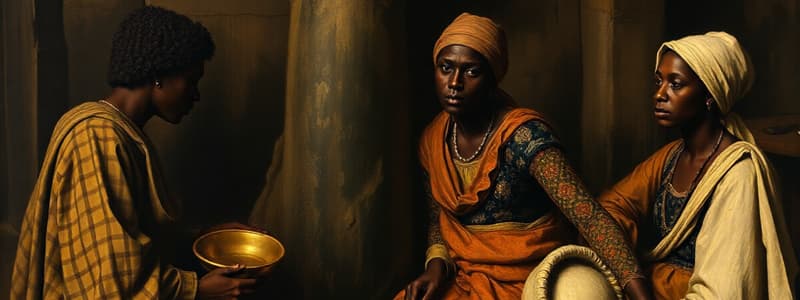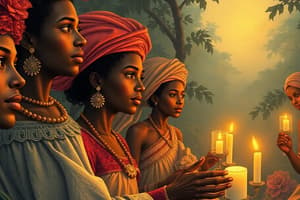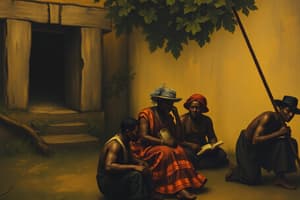Podcast
Questions and Answers
Describe the evolution of labor practices in the English colonies, leading to the widespread adoption of slavery by the mid-1700s.
Describe the evolution of labor practices in the English colonies, leading to the widespread adoption of slavery by the mid-1700s.
Initially, English colonies relied on indentured servants. Over time, as labor demands increased, colonial governments legalized slavery, leading to its widespread adoption by the mid-1700s as a primary labor source.
Explain how enslaved people resisted slavery, both overtly and covertly, and provide examples of each type of resistance.
Explain how enslaved people resisted slavery, both overtly and covertly, and provide examples of each type of resistance.
Enslaved people resisted slavery both overtly, through rebellions, and covertly, by breaking tools, feigning illness, or working slowly. These actions aimed to disrupt the system and assert their agency.
In what ways did enslaved people preserve their culture and find sources of strength amidst the hardships of slavery?
In what ways did enslaved people preserve their culture and find sources of strength amidst the hardships of slavery?
Enslaved people preserved their culture by telling stories, singing songs about Africa, and playing musical instruments. Christianity also became a source of strength for some, providing spiritual solace and community.
Discuss the legal status of enslaved children and how it impacted enslaved families.
Discuss the legal status of enslaved children and how it impacted enslaved families.
How did the treatment of enslaved people vary, and what factors influenced the conditions they faced?
How did the treatment of enslaved people vary, and what factors influenced the conditions they faced?
Flashcards
Slavery in Colonial America
Slavery in Colonial America
System where Africans were brought to America to work, especially in the Southern colonies.
Treatment of Enslaved People
Treatment of Enslaved People
Africans were often mistreated, beaten, and families were split apart.
Resistance to Slavery
Resistance to Slavery
Breaking tools, working slowly, pretending to be sick, rebellion and preserving African Culture.
Preserving Culture
Preserving Culture
Signup and view all the flashcards
Overseer
Overseer
Signup and view all the flashcards
Study Notes
- Traders brought millions of Africans to North and South America, and the Caribbean for over 300 years
- Enslaved people were taken, chained together, and sold
Treatment of Enslaved People
- Africans arrived in the English colonies likely in Virginia, in 1619
- The colonies first used indentured servants, but transitioned to more enslaved workers as the need for labor grew
- By the mid-1700s, slavery was legal in every colony
- Laws stated that children born to enslaved people were also enslaved
- Families were often separated
Life as an Enslaved person
- Most enslaved Africans in the Southern Colonies worked on plantations
- Treatment varied; enslaved people were often beaten and abused
- Escape attempts were made despite the difficulty
- Resistance included rebellion, sabotage, feigning illness, and working slowly
- Acts of resistance were met with harsh punishments
- Culture was preserved through storytelling, singing, and music, including playing drums and banjos
- By the late 1700s, Christianity became a source of strength
Farming economy
- Southern Colonies economy was based on plantations, which depended on enslaved labor
- Cash crops produced by enslaved workers made plantation owners wealthy
- Plantations were first built along the Coastal Plain, expanding inland by 1750
- Plantations resembled small villages with workshops for making nails, bricks, barrels, etc
Plantation System and Roles
- Plantation owners hired overseers to supervise enslaved people
- Overseer's houses were near the fields, while enslaved workers' houses were farther away
- Enslaved people maintained small gardens near their homes when they weren't working the owner's land
- Planters managed the plantations but didn't usually do the manual labor
- Planters served as community judges or colonial assembly members
- They hired teachers for their children, unlike enslaved children who were prohibited from attending school
- Enslaved people were punished for learning to read or write
Life on small farms
- Though larger plantations were more prominent, most colonists lived on smaller farms
- Though not often wealthy, former indentured servants sometimes owned these smaller farms
- Most owners of small farms did not have enslaved people, and if they did, they generally worked alongside them and did not treat them as equals
- Due to distance, church services were important social events and sometimes required considerable travel
Free Africans
- Some Africans bought freedom and started farms, but avoided being part of the slavery system
- Freed Africans sometimes purchased relatives to emancipate them
- Many escaped slavery, but were often captured and returned; some escaped from Spanish Florida
- Some were supported by Native American tribes
Black Seminoles
- The Seminole tribe gave runaways food, land, and shelter in exchange for one-third of their crops raised
- Many runaways dressed like and learned the language of the Seminole, becoming known as Black Seminoles
Eliza Lucas Pinckney
- Eliza Lucas Pinckney moved to South Carolina in 1738 when she was 16
- Started experimenting with indigo seeds received from her father, working with such dedication that she "hardly allowed herself time to sleep or eat."
- Three years later, Eliza grew an indigo plant that produced an excellent dye
- Within a few short years South Carolina planters were selling one million pounds per year of indigo to cloth makers in Europe
Cash crops
- Seaports like Charles Town were important to the Southern Colonies economy
- Plantations produced tons of cash crops like tobacco, rice, and indigo
- These crops needed to be shipped to markets in England and the West Indies for sale
Adapting to the Climate
- Tobacco was the main cash crop in Maryland, Virginia, and northern North Carolina due to the climate
- This crop required substantial land and labor and depleted the soil's nutrients after about seven plant cycles
- Rice became the major cash crop known as "Carolina gold" in southern North Carolina, South Carolina, and Georgia
- Indigo, which grows well in dry climate, became a major cash crop and dye source after Eliza Lucas Pinckney experimented with it
- By the 1740s, indigo was a major cash crop throughout South Carolina
The Economy Grows
- Though plantations were often self-sufficient, they depended on merchants and others for goods and services
- Interdependence: The term for mutual needs of economic resources
- More cash corps were exported as plantations got larger
Exporting goods and impact of location
- Planters sold their crops through a broker, who was paid to buy and sell for them
- Brokers took the crops to market to sell and acquired needed goods for planters
- Successful plantations were located near rivers and ports for easier accessible shipping
- By the mid 1700s, cites such as Norfolk and Savannah had grown substantialy
Baltimore Industry
- Founded in 1729 on the Patapsco River, which flows into Chesapeake Bay
- Baltimore exported large amounts of grain and tobacco
- The demand for new ships saw a growth, and the city became a major center for shipbuilding
- Over time, shipbuilders developed the Baltimore clipper, one of the world's fastest sailing ships
Other Industries
- Farming was significant and important to the economy, where the forests were also important natural resources
- Wilmington, North Carolina was known for it's resources
Studying That Suits You
Use AI to generate personalized quizzes and flashcards to suit your learning preferences.
Related Documents
Description
Millions of Africans were brought to the Americas over 300 years in the slave trade. Arriving in the English colonies around 1619, they faced harsh treatment and abuse while working on plantations. Despite facing challenges, they resisted and preserved their culture through storytelling, singing, and music.




